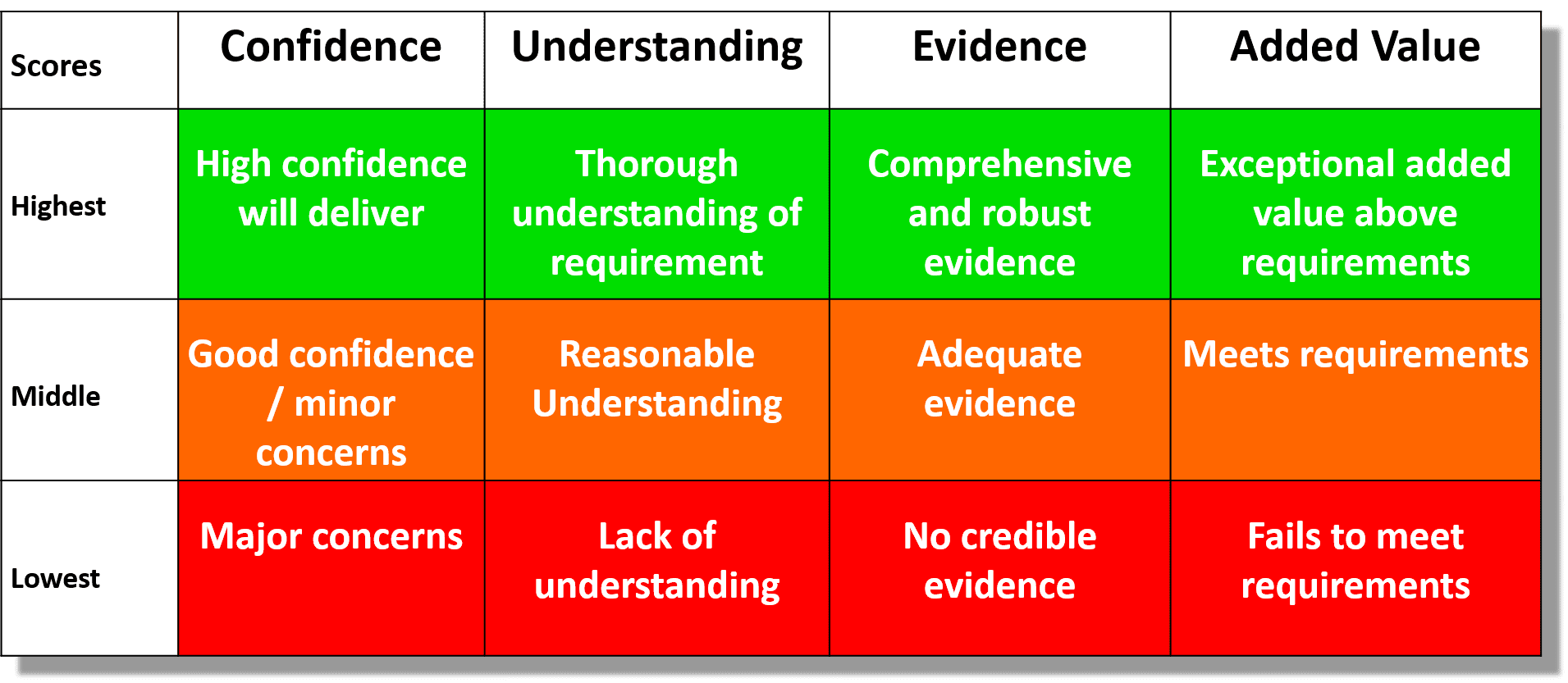When we are answering an RFP or IFB questions, we always look carefully at what the customer has said to get the best score. The evaluation regime will often have 4 or 5 possible scores, ranging from 0 (didn’t answer the question) up to 5 as the best score.
Over time, we recognized there are a number of common elements in customers’ descriptions of what would elicit a good score for an answer. To confirm our direct experience, we did research. We used FOIA requests to get over 100 sets of evaluation criteria from government agencies in the UK.
Results of our research
We found there are four common things customers look for in evaluating answers. And as a bidder, you can prepare for all of them prior to knowing what the exact question will be.
The four common elements are shown in the table below, together with an overview of what customers expect to see in order to get the different levels of scoring for an answer.

Let’s look quickly at each of these four elements in turn. Then look at how you can prepare to get the best scores for each area.
1. Confidence
Customers want your answer to give them confidence you will deliver their requirements. Some quotes from evaluation criteria (for the highest scores) include: “High confidence in ability to deliver”, “Offers full confidence that the proposer will deliver the service in full”. For lower scores, the description of what the answer contains would involve less confidence and risk.
2. Understanding
Customers want you to show that you clearly understand their requirements. Quotes from evaluation criteria for the highest scores include, “Evaluator has been able to identify that the potential provider has an excellent understanding of the requirements”, “Demonstrates a thorough understanding of what is being asked for”.
3. Evidence
Customers want you to provide evidence to back up your assertions in your answers. To get the highest scores here, they will ask for: “Excellent evidence that demonstrates how targets will be achieved”, etc.
4. Added Value
To get the highest scores, customers expect your answer to give them more than they have asked for. For example: “Has exceeded all requirements and gives confidence the provider will add real value”.
Not all scoring regimes will include all four of these elements. But they are by far the most common we found. A typical scoring matrix for the highest score may include something like this real example:
Preparing to get the highest scores
Demonstrating understanding, giving confidence, providing evidence and delivering an added value solution comes only with advance preparation. We will focus on incumbent bidders, but this applies even more to new bidders.
Even though you may not know the precise questions you will be asked in the RFP, you should be able to make a good guess. Look at:
- The main areas of work you are delivering
- The customer’s key needs
- The original RFP
- Other procurements your customer has made recently
- The types of question other customers are asking for similar contracts
- The areas likely to change in the new contract – e.g., new areas of scope, or changes in specifications
These items should give you enough info to be able to anticipate the questions in the RFP. And remember you are not trying to write the answer now. You are preparing the background information that will enable you to write a high scoring answer.
Providing confidence
Your proposal writers need to have a clear understanding of the performance levels you have achieved on the contract. And ideally have these in graphics, charts or tables. They need to understand the risks involved in the contract, and how you have mitigated them, so you can demonstrate a low risk solution.
This knowledge doesn’t just happen. You need to spend time analysing your contract over the whole of its life. Ideally you want to be able to show an improvement in performance. In particular the initiatives you have put in place to deliver that improvement.
Showing understanding
As the incumbent you should have the best understanding of your customer and their requirements of all bidders. But do your solution developers and your bid writers?
On a detailed level do you understand the specifics of demand from the customer on the contract? On a strategic level do you understand the main drivers, worries, plans and changes the customer at a strategic level faces, and how your contract may help them with these?
Understanding the future as well as the past
Another area of understanding, one that incumbents can fail on, is understanding the changes in the customer’s requirements for the new contract. Incumbents often fail to properly take on board changes in scope, specification etc. in recompetes. Instead they offer ‘more of the same’.
Taking time to understand what needs to change, and putting together a solution that will deliver that change before you see the RFP questions will save you having to write and develop the solution at the same time.
Supporting your answer with Evidence
As the incumbent, you should have plenty of evidence to support your solution and answers. Spending time before your bid to gather evidence about your delivery will give you this detail, ready to back up your answers. Remembering that the focus in your answers should be using this evidence to show how you will deliver in the future.
Adding value
Spend time prior to the bid understanding your existing contract, the customer’s future needs. And work out how you can offer something above the core requirements to deliver something innovative and value adding. Then describing this in your answers and the benefits it will bring will be much more likely to get you the score for added value.

Summary
The easiest and cheapest way to win the contract is to complete the research needed to prepare to win in advance. Gathering conclusive information on the four items discussed above — Confidence, understanding, evidence, and added value — can put you in an unbeatable position, even before the RFP is released.
Note: Nigel Thacker is an OCI business partner and arguably the leading authority on recompete proposals.





Leave A Comment